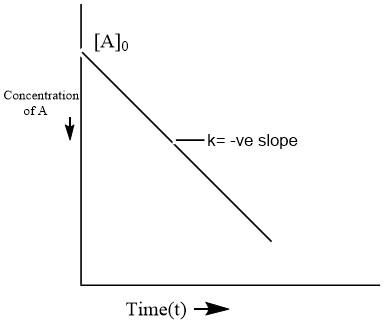
For, a zero-order reaction, the plot of concentration of reactant versus time is:
(Intercepts refers to the concentration axis)
A. Linear with +ve slope and negative intercept
B. Linear with -ve slope and zero intercept
C. Linear with -ve slope and non-zero intercept
D. Linear with +ve slope and non-zero intercept
Answer
561.6k+ views
Hint: Zero-order reaction is a chemical reaction where the rate of reaction does not vary with the increase or decrease in the concentration of the reactants. Therefore, the rate of these reactions is always equal to the rate constant of the specific reactions (since the rate of these reactions is proportional to the zeroth power of reactants concentration).
Complete step by step answer:
The differential form of zero-order reaction can be written as:
\[\Rightarrow Rate\text{ }=~\dfrac{~-dA}{dt}=k{{[A]}^{0}}=k\]
Where ‘Rate’ refers to the rate of the reaction and \[k\] is the rate constant of the reaction.
This differential form can be rearranged and integrated on both sides to get the required Integral form as shown below.
\[\Rightarrow Rate\text{ }=~\dfrac{~-dA}{dt}=k\], multiplying on both sides with \[dt\] we get;
\[\Rightarrow d[A]=-kdt\], integrating on both sides we get,
\[\int\limits_{{{[A]}_{0}}}^{[A]}{d[A]}=-\int\limits_{0}^{t}{kdt}\]
Where \[{{[A]}_{0}}\] is the initial concentration of the reactant [A] at time t=0. Solving for [A], we get:
\[\Rightarrow [A]={{[A]}_{0}}kt\]
\[\Rightarrow [A]=-kt+{{[A]}_{0}}\]
Which is the required integral form. On comparing this equation with the equation of a straight line \[(y=mx+b)\], an \[[A]\] against t graph can be plotted to get a straight line with slope equal to \[-k\] and intercept equal to \[{{[A]}_{0}}\] as shown below.

Here, we can see that the graph of a zero-order reaction is linear with -ve slope and non-zero intercept.
So, the correct answer is Option C.
Note: Other than zero-order reaction, there are first order reaction and second order reaction, whose graphs are different from zero-order reaction. The reaction of hydrogen with chlorine (Photochemical reaction) and decomposition of nitrous oxide over a hot platinum surface are examples of zero-order reaction.
Complete step by step answer:
The differential form of zero-order reaction can be written as:
\[\Rightarrow Rate\text{ }=~\dfrac{~-dA}{dt}=k{{[A]}^{0}}=k\]
Where ‘Rate’ refers to the rate of the reaction and \[k\] is the rate constant of the reaction.
This differential form can be rearranged and integrated on both sides to get the required Integral form as shown below.
\[\Rightarrow Rate\text{ }=~\dfrac{~-dA}{dt}=k\], multiplying on both sides with \[dt\] we get;
\[\Rightarrow d[A]=-kdt\], integrating on both sides we get,
\[\int\limits_{{{[A]}_{0}}}^{[A]}{d[A]}=-\int\limits_{0}^{t}{kdt}\]
Where \[{{[A]}_{0}}\] is the initial concentration of the reactant [A] at time t=0. Solving for [A], we get:
\[\Rightarrow [A]={{[A]}_{0}}kt\]
\[\Rightarrow [A]=-kt+{{[A]}_{0}}\]
Which is the required integral form. On comparing this equation with the equation of a straight line \[(y=mx+b)\], an \[[A]\] against t graph can be plotted to get a straight line with slope equal to \[-k\] and intercept equal to \[{{[A]}_{0}}\] as shown below.

Here, we can see that the graph of a zero-order reaction is linear with -ve slope and non-zero intercept.
So, the correct answer is Option C.
Note: Other than zero-order reaction, there are first order reaction and second order reaction, whose graphs are different from zero-order reaction. The reaction of hydrogen with chlorine (Photochemical reaction) and decomposition of nitrous oxide over a hot platinum surface are examples of zero-order reaction.
Recently Updated Pages
A man running at a speed 5 ms is viewed in the side class 12 physics CBSE

The number of solutions in x in 02pi for which sqrt class 12 maths CBSE

State and explain Hardy Weinbergs Principle class 12 biology CBSE

Write any two methods of preparation of phenol Give class 12 chemistry CBSE

Which of the following statements is wrong a Amnion class 12 biology CBSE

Differentiate between action potential and resting class 12 biology CBSE

Trending doubts
What are the major means of transport Explain each class 12 social science CBSE

Which are the Top 10 Largest Countries of the World?

Draw a labelled sketch of the human eye class 12 physics CBSE

Explain sex determination in humans with line diag class 12 biology CBSE

Explain sex determination in humans with the help of class 12 biology CBSE

Differentiate between homogeneous and heterogeneous class 12 chemistry CBSE




